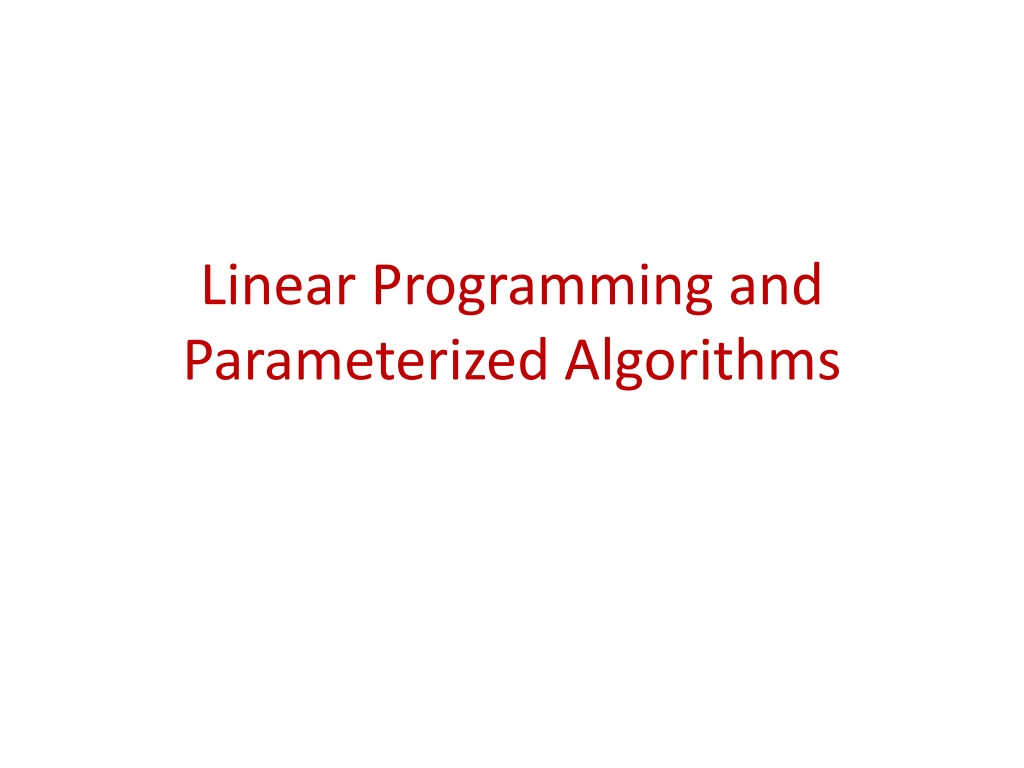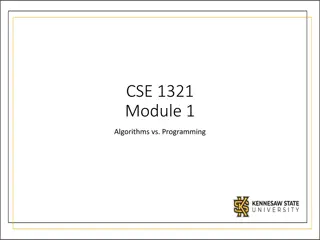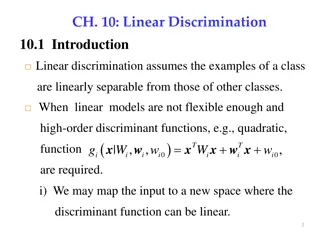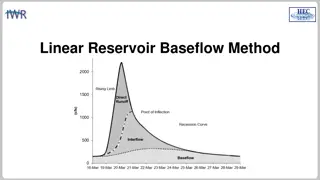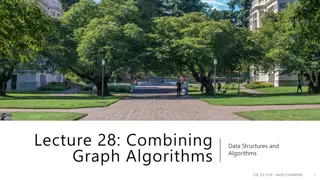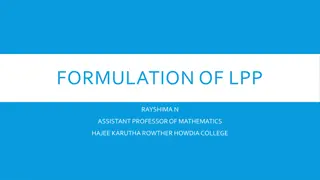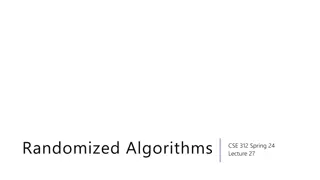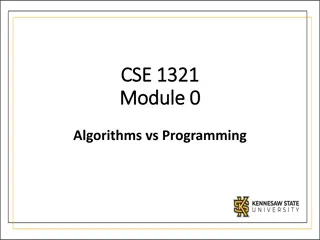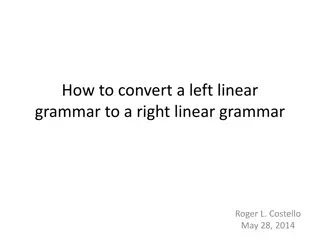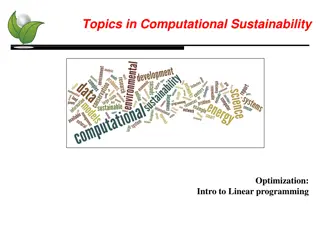Linear Programming and Algorithms
Delve into the world of linear programming, integer linear programming, vertex cover, matchings, and theorem demonstrations. Learn about linear objective functions, NP-completeness, optimal solutions, and the applications of various algorithms in optimizing mathematical models.
Download Presentation

Please find below an Image/Link to download the presentation.
The content on the website is provided AS IS for your information and personal use only. It may not be sold, licensed, or shared on other websites without obtaining consent from the author.If you encounter any issues during the download, it is possible that the publisher has removed the file from their server.
You are allowed to download the files provided on this website for personal or commercial use, subject to the condition that they are used lawfully. All files are the property of their respective owners.
The content on the website is provided AS IS for your information and personal use only. It may not be sold, licensed, or shared on other websites without obtaining consent from the author.
E N D
Presentation Transcript
Linear Programming and Parameterized Algorithms
Linear Programming n real-valued variables, x1, x2, , xn. Linear objective function. Linear (in)equality constraints. Solvable in polynomial time. y x = 8 0 x,y 10 Maximize x + y 3x + 2y 20
Integer Linear Programming n integer-valued variables, x1, x2, , xn. Linear objective function. Linear (in)equality constraints. NP-complete. Lingo: Linear Programs (LP s), Integer Linear Programs (ILP s) Easy to encode 3-SAT (Exercise!)
Vertex Cover In: G, k Question: ? ? ? , ? k such that every edge in G has an endpoint in S? Have seen a kernel with O(k2) vertices, will see a kernel with 2k vertices.
Vertex Cover (I)LP In: G, k Question: ? ? ? , ? k such that every edge in G has an endpoint in S? Minimize ?? ?? ? ? :??+ ?? 1 ?? 0 ?? Z OPTLP OPT
Nemhauser Trotter Theorem (a)There is always an optimal solution to Vertex Cover LP that sets variables to {0 ,1 2,1}. (b)For any optimal {0 ,1 matching from the 1-vertices to the 0-vertices, saturating the 1-vertices. 2,1} solution there is a
Matchings and Hall Sets A matching in a graph is a set of edges that do not share any endpoints. A matching saturates a vertex set S if every vertex in S is incident to a matching edge. A vertex set S is a Hall set if it is independent and |N(S)| < |S|. A Hall set may never be saturated!
Halls Theorem Theorem: A bipartite graph has a matching such that every left hand side vertex is saturated there is no Hall set on the left hand side.
Halls Theorem Example Matching (so no Hall set) Hall set (so no matching)
Nemhauser Trotter Theorem (a)There is always an optimal solution to Vertex Cover LP that sets variables to {0 ,1 2,1}. (b)For any {0 ,1 from the 1-vertices to the 0-vertices, saturating the 1-vertices. 2,1} solution there is a matching
Nemhauser Trotter Proof <? Right ? + + ? >? ? - - - Left ? This clearly proves (a), but why does it prove (b)? ? ?
Reduction Rule If exists optimal LP solution that sets xv to 1, then exists optimal vertex cover that selects v. Remove v from G and decrease k by 1. Correctness follows from Nemhauser Trotter Polynomial time by LP solving.
Kernel Suppose reduction rule can not be applied and consider any {0 ,1 2,1} optimal solution to LP. No vertex is 0 (remove isolated vertices) No vertex is 1. All vertices are 1 2. OPTLP k. 1 2n k n 2k
Above LP Vertex Cover So far we have only seen the solution size, k, as the parameter for vertex cover. Alternative parameter = k OPTLP Note that can be very small even if k is big!
Vertex Cover Above LP In: G, k. Question: Does there exist a vertex cover S of size at most k? Parameter: k OPTLP where OPTLP is the value of an optimum LP solution. Now FPT means f(k OPTLP)nc time!
Reduction Rule Recall the reduction rules from the kernel for Vertex Cover: If exists optimal LP solution that sets xv to 1, then exists optimal vertex cover that selects v. Remove v from G and decrease k by 1. Remove vertices of degree 0. Now the unique LP optimum sets all vertices to 1 2
Reduction affects k-OPTLP? Reduction rule: If exists optimal LP solution that sets xvto 1 Remove v and decrease k by 1. OPTLPdecreases by exactly 1. Why? Feasible LP Solution to G\u v 1 k-OPTLP is unchanged!
Branching Pick an edge uv. Solve (G\u, k-1) and (G\v, k-1). LP(G\u) > LP(G) 1 since otherwise there is an optimal LP solution for G that sets u to 1. 1 2 Then LP(G\u) LP(G)
Branching - Analysis OPTLP k drops by ... in both branches! 12 4? ? 1 4? ? ? 2? ? Total time: 4k-OPTLP nO(1)
Vertex Cover recap Using LP s we can get - a kernel with 2k vertices, - an algorithm that runs in time 4k-OPTLP nO(1). Is this useful when compared to a 1.38k algorithm?
Almost 2-SAT In: 2-SAT formula ?, integer k Question: Can we remove* k variables from ? and make it satisfiable? *Remove all clauses that contain the variable
Odd Cycle Transversal (OCT) In: G, k Question: ? ? ? , ? k such that G\S is bipartite? Will give algorithms for Almost 2-SAT and OCT, using FPT-reductions to Vertex Cover above LP!
Odd Cycle Transversal Almost 2-Sat ? ? ? ? x y x y ? ? ? ? z ? ? ? ? z
Almost 2-SAT Vertex Cover/k-LP ? ? ? ? ? ? ? ? ? ?
Consequences 4knO(1) time algorithms for Almost 2-SAT and Odd Cycle Transversal. A ck-OPTLP nO(1) algorithm for Vertex Cover automatically gives ck-OPTLP nO(1) algorithm for Almost 2-SAT and Odd Cycle Transversal. Can get a 2.32k-OPTLP nO(1) algorithm for Vertex Cover by improving the branching.
LP versus ILP We saw an application of LP s in parameterized algorithms. ILP solving is NP-hard. Useless for algorithms? No! We can use parameterized algorithms for Integer Linear Programming.
Integer Linear Programming Theorem: k4.5kpoly(L) time algorithm, where k is the number of variables, and L is the number of bits encoding the instance.
Closest String Input: n strings s1 sn over an alphabet A, all of same length L, and an integer k. Question: Is there a string s such that for every i, d(s, si) k? Parameter: n Note: the parameter is the number of strings, not k
Closest String as Hit & Miss For every position, need to choose the letter of solution string s. For all strings s differs from at that position, increase distance by one. Can t miss any string more than k times.
Closest String Alphabet Reduction Can assume that alphabet size is at most n. 1111111111111111 1234123412342222 3214321443322114 1 1 2 1 2 2 1 2 1 1 2 2 111111111111 122212222222 221223232113
Column Types 1 1 2 1 1 1 2 1 1 2 1 1 2 111111111111 122212222222 221223232113 2 3 4 5 112 122 113 122 121
Closest String ILP After alphabet reduction, there are at most nn column types. Count the number of columns of each column type.
ILP For each column type, make n variables, one for each letter. ??? = number of columns of type t where the solution picks the letter a. Constraints: For each column type t, the chosen letters add up to the number of type t.
Objective Function For a string si and column type t, let si[t] be the letter of si in columns of type t. For each string si, its distance from the solution string s is ??? ??= ?????? ? ??[?] ???? ? Objective is Minimize Max di
Algorithm for Closest String Number of variables in the ILP is n nn so the final running time is FPT in n. (double exponential)
Conclusions (Integer) Linear Programming is a useful tool for parameterized algorithms. Has not yet been explored in great depth
Exercises Show that ILP is NP-hard. Show that the clause deletion version of Almost 2-SAT is FPT by reduction to Almost 2-SAT. Book: 3.20, 3.23
Surplus The surplus of an independent set I is |N(I)| |I|. The surplus can be negative! In any {0 ,1 n/2 + surplus(V0)/2. 2,1}-LP solution, the total weight is Solving the Vertex Cover LP is equivalent to finding an independent set I of minimum surplus.
Surplus ? ? ? ?
Surplus and Reductions If all is the unique LP optimum then surplus(I) > 0 for all independent sets. Can we say anything meaningful for independent sets of surplus 1? 2? k?
Surplus Branching Lemma Let I be an independent set in G with minimum surplus. There exists an optimal vertex cover C that either contains I or avoids I.
Surplus Branching Lemma Proof I S I S I N(I) R
Branching Rule Find an independent set I of minimum surplus. Branch: Either put all of I into solution, or put all of N(I) into solution. Correct by branching lemma. Need to analyze measure drop in both branches.
Branching Rule Find an independent set I of minimum surplus. Solve (G\I, k-|I|) and (G\N(I), k-|N(I)|). LP(G\I) > LP(G) - |I|, since otherwise LP(G) has an optimal solution that sets I to 1. So ?? ?\I ?? ? ? +1 2 k-LP drops by at least .
Branching Rule Analysis Contd Analyzing the (G\N(I), k-N(I)) side: LP(G\N(I)) + |N(I)| = n/2 + surplus(I)/2 ? LP(G\N(I)) + |N(I)| = n/2 + surplus(I)/2 LP G + surplus(I)/2 LP with ?? = 0 = Best LP with ?? = 0 = Feasible 1/2 v I So LP(G\N(I)) LP(G) |N(I)| + surplus(I)/2 N(I) 0 1 k-LP drops by at least surplus(I)/2
Branching Summary The measure k-LP drops by ( , surplus(I)/2). Will see that independent sets of surplus 1 can be reduced in polynomial time! Measure drops by ( ,1) giving a ? 2.618? ?? time algorithm for Vertex Cover
Reducing Surplus 1 sets. Lemma: If surplus(I) = 1, I has minimum surplus and N(I) is not independent then there exists an optimum vertex cover containing N(I). I N(I) R
Reducing Surplus 1 Sets If surplus(I) = 1, I has minimum surplus and N(I) is not independent, delete N[I] and decrease k by |N(I)|. LP decreases by at most |N(I)| (why?) So k - OPTLP does not increase.
Reducing Surplus 1 sets. Reduction Rule: If surplus(I) = 1, I has minimum surplus and N(I) is independent then solve (G ,k-|I|) where G is G with N[I] contracted to a single vertex v. OPTLP decreases by at most |I| (why?) I N(I) R
